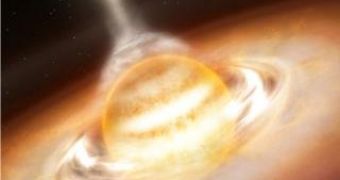Brown dwarfs are not fully understood stars and the latest observations confirmed this by photographing such a star throwing jets of matter, a process characteristic of young stars. So, it would seem that these dwarfs follow a similar formation pattern to the one of normal stars, but outflows are driven out by these celestial bodies.
This particular type of stars have a mass below that necessary to maintain hydrogen-burning nuclear fusion reactions in their cores, as do stars on the main sequence, but which have fully convective surfaces and interiors, with no chemical differentiation by depth. Brown dwarfs occupy the mass range between that of large gas giant planets and the lowest mass stars (anywhere between 75 and 80 Jupiter masses).
Using ESO's Very Large Telescope (VLT), the astronomers found a brown dwarf that they called 2MASS1207-3932, which has a surprising behavior. Around that star, there is also a planet, a gas giant having 5 times the mass of Jupiter, which is actually the first confirmed exoplanet.
The problem is that, having a mass only 25 times larger than Jupiter's, this star should not drive an outflow. Yet it does. Normally, only young stars, called T-Tauri stars, have large and bright enough jets to be observed directly.
"This leads us to the tantalizing prospect that young giant planets could also be associated with outflows," says Emma Whelan, the lead-author of the paper reporting the results.
It was the special observation technique called "spectro-astrometry" that allowed astronomers to catch a glimpse of this midget, since finding such a star in space is like trying to spot a 2 Euro coin from 40 kilometers away.
"Discoveries like these are purely reliant on excellent telescopes and instruments, such as the VLT," says Whelan. "Our result also highlights the incredible level of quality which is available today to astronomers: the first telescopes built by Galileo were used to observe the moons of Jupiter. Today, the largest ground-based telescopes can be used to observe a Jupiter size object at a distance of 200 light-years and find it has outflows!"

 14 DAY TRIAL //
14 DAY TRIAL //